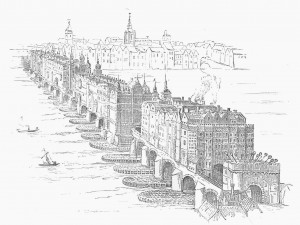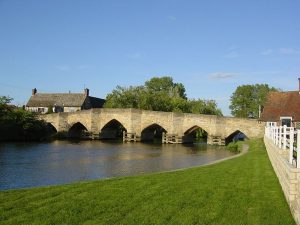Q: What Does the Name of the Bridge of Stonebows Refer To?
ANSWER: Some people believe the Bridge of Stonebows (later renamed the Brandywine Bridge or simply the “Great Bridge” by the Hobbits of the Shire) must have been so named because it was guarded by “stone bows”. A stone bow is a sort of crossbow that flings stone pellets rather than arrows.
However, it seems more likely to me that the bridge’s name reflects its architecture. There are, in fact, places in England where bridges are named “Bow Bridge” or the locations are called “such-and-such-AT-BOW(e)” (where “Bow(e)” refers to a bridge).

Ancient and medieval bridges had to be built in series of arches or spans because the materials and engineering knowledge of those times were incapable of producing bridges like modern bridges made of metal. Although Roman bridges were quite efficient and often elegant, medieval bridge-engineers surpassed their Roman predecessors in several ways — not least of which was devising methods for creating larger, wider spans (sometimes called “bows”). The widest known span of any medieval bridge was about 70 metres (over 200 feet), although most of the larger bridges appear (to the best of my knowledge) to have used spans (bows) in the range of 40-50 metres.
Some of these architectural spans or arches used the “Gothic” style, where the arches rose to points (a feature that was common in Gothic cathedrals). Other spans used more rounded arches. The arches were sometimes constructed by building a stone column on an eyot (perhaps even an artificial one) in the middle of the river. Some bridges used columns/arches that were built on foundations that ran across the river beds. A wide river might require a dozen of these columns. The columns arched out to either side to join with other columns and support the roads.

The largest bridges could hold entire buildings on them. London Bridge is, of course, famous for having supported many buildings almost up to modern times. Many medieval bridges have either been replaced or torn down (they were often destroyed in wars to prevent hostile forces from crossing rivers).
There is no published text of which I have heard that would explain or imply a need for crossbow-like weapons to be mounted on the bridge crossing the Brandywine river. Although Gil-galad and his allies held a frontier at the Brandywine against Sauron’s invasion in the middle of the Second Age, I think it highly doubtful there would have been any strategic advantage to mounting weapons on the bridge as they could only have been used against boats or swimmers in the water and not to prevent an army from crossing the river.
In the Third Age the only time a hostile force is said to have approached the Brandywine river was during the final war in which Angmar destroyed Arthedain. The reader is free to infer that inter-kingdom strife between Arthedain and Cardolan might have required some defense of the Brandywine but so far as I can determine stonebows (which are first mentioned in the 1300s) were too weak (compared to normal crossbows and longbows) to be used in battle; they were apparently only suited for sport (maybe for hunting birds).
So if you are not satisfied with the idea that the bridge may have been named for its arches, then you could argue (with absolutely no textual support) that stonebows were used on the bridge for sporting competitions. While this might seem an interesting concept for fan fiction or role-playing games there is no real reason to suggest that such an interpretation was as likely as the first.
Since J.R.R. Tolkien does not seem to have explained the name anywhere we can argue until the sun turns blue and no one will necessarily be proven correct; but for my part I will continue to suggest that the bridge was most likely named for the arches and nothing else.
See also:
# # #
Have you read our other Tolkien and Middle-earth Questions and Answers articles?

That’s what I always assumed. Another form of arch bridge is the elliptical arch, which is flatter than a circular arch, just the opposite of the Gothic arch. While there are several styles, depending on how the curve is calculated, all look even more like a bow than the circular arch.
Given the Numenorean’s love of stonework, such a bridge would be natural for them. And, since the road was a major trade route for the Dwarves, if the Men didn’t build in stone, the Dwarves almost certainly would have.
I agree with your view, Michael. It had never occurred to me that stonebows could refer to anything but the bridge’s architecture. Besides, were there crossbows or stone bows in Middle-earth? I don’t think Tolkien ever mentioned them, or did he?
I don’t recall any reference to crossbows in any of Tolkien’s Middle-earth stories, but there may have been one in another of his tales (perhaps “Farmer Giles”, for example).